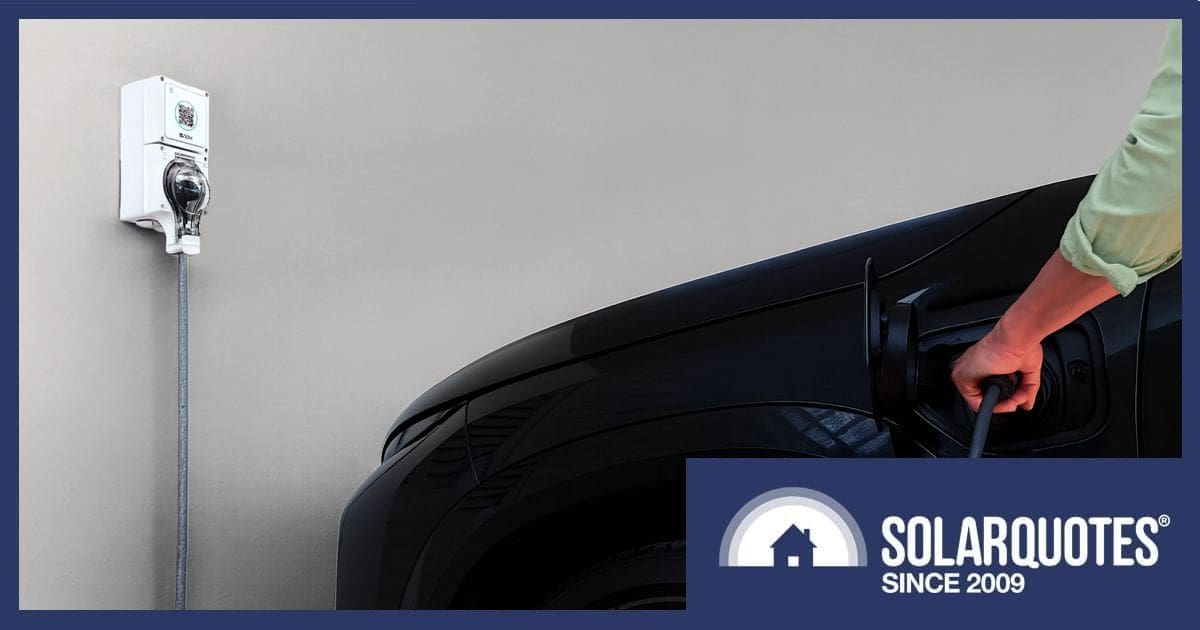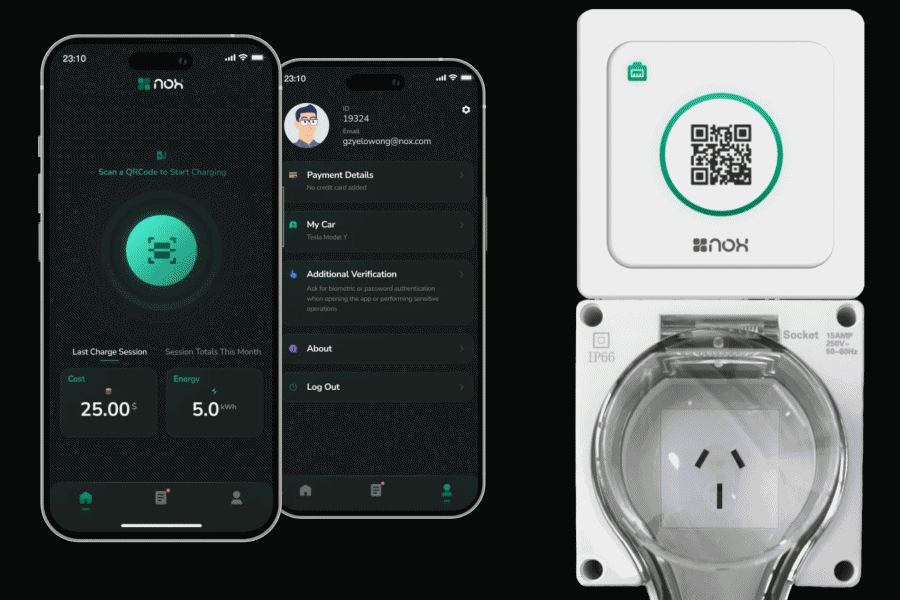The Australian Renewable Energy Agency (ARENA) is supporting a project that will see ‘intelligent power sockets’ installed in selected apartment buildings nationwide to power Level 1 EV charging.
What’s The Apartment EV Charging Project Involve?
The “Accelerating EV Adoption by Unlocking Charging for Strata Residents” initiative is being led by NOX Energy. It will provide user-pays home EV charging access to residents of 16 buildings via installation of close to 2,000 of its Intelligent Power Sockets (IPS), which look like a standard power outlet with some added bling housing advanced features.
The total project investment is $4.78 million, including $1.51 million from ARENA.
NOX Energy’s website indicates its IPS hardware costs around $425 a pop and installation is usually in the range of $250 – $750. At the upper end, that works out to an installation cost of around $1,175.
But $4.78 million divided by 2,000 equals an average cost of $2,390. So, what gives? NOX says the buildings involved will requiring upgrades ranging from minor electrical work to full infrastructure retrofits, which help could explain it.
Added: 30 September. NOX have since informed me:
“… the grant will also support infrastructure for scaled, L1 charging. This could include cable trays, wi-fi networks, and distribution boards. We still expect the fully installed cost of our hardware will be $500-$1,000/IPS.”
The project also involves resident surveys and monitoring performance data. Findings with actionable insights for strata communities, policymakers, and the EV industry will be published.
“These sites will deliver a comprehensive real-world test of EV charging in diverse strata environments,” states the firm. “Where rooftop solar is present, NOX Energy will test innovative load-shifting behaviours that encourage residents to charge during periods of high solar export, helping buildings boost self-consumption and cut charging costs.”
The ARENA funding has been granted under the Agency’s Driving the Nation Program, a $500 million initiative supporting cheaper and cleaner transport.
What Is Level 1 Charging?
Level 1 EV charging uses a general power outlet (GPO) and the charger usually included with electric vehicles. Also known as granny chargers, bricks or trickle chargers, Level 1 devices charge at 1.8 to 2.4 kW from a standard 10 Amp socket, adding around 10 kilometres of range per hour. (Added: A 15 Amp power outlet can deliver more — 1.8 – 3.5 kW, up to 20 km range per hour — if the charger is compatible and supports it).
It’s significantly less compared to hard-wired home EV chargers (Level 2), but for some EV owners it’s all they’ll need.
Learn more about Level 1, 2 and 3 charging.
What Makes Nox Energy’s IPS Different From A GPO?
- NOX designs and manufactures their IPS.
- Both a 10A and 15A version available.
- OCPP compliant.
- Wi-Fi, LAN, and Bluetooth connectivity. Bluetooth is critical as it allows IPS to mobile phone connectivity in basement areas where there is no reception
- RFID functionality.
- Fully cloud-based, ’round-robin’ time-based load balancing. While the NOX Energy website also mentions First in/First out simple load balancing, the company has since told me it believes it’s not a viable method for load management, particularly with trickle charging.
- Full visibility of all energy consumed with granularity down to the individual power point.
- Real time monitoring, immediately ceasing charging if problems are detected.
- App based and tap-and-go payments.
- The system accommodates fluctuating electricity prices during peak and non-peak hours.
NOX Energy says contact surfaces of the IPS have been tested to ensure 10,000+ plug cycles. The IPS is also waterproof and dustproof to IP56 and IP66 standards.
How Does The NOX Energy IPS System Work?
Once installed, users download the NOX Energy App and use that to scan the QR code1 on the IPS to start a session.
Charging can be constant, timed or scheduled.
Each user pays for the energy consumed during their charging session and the kilowatt-hour rate is set based on the strata’s electricity supply costs. The strata is also able to recoup costs for related infrastructure work with an added charge; dropping that charge once costs have been recovered.
“Our model removes cost and complexity for strata communities, providing affordable and accessible EV charging for older complexes and new builds,” said NOX Energy Chief Operating Officer Charlie Richardson.
For its role in all this, NOX adds a $0.05 – $0.10 per kWh (ouch!) tariff according to its website for maintenance, updates, and management system access. At the end of the billing cycle, the body corporate or management company is automatically reimbursed for the energy consumed.
Added 30 September: NOX has informed me:
“Our website mentions $0.05-$0.10 but that is to cover models where we might partially subsidise our device + installation. The ARENA program and all our residential strata installations to-date have been at $0.05/kWh.”
NOX Energy isn’t the only local company offering such a solution — another is Alchemy Charge’s SmartPoint.
Learn more: Apartment EV Charging: Strata-Friendly Solutions For Residents
Footnotes
- The rise of “quishing” is a concern — where malicious QR codes trick people into visiting fake websites, downloading malware, or divulging personal and financial information. I’m assuming that even if a fake QR code sticker was placed over the authentic one on the IPS, it simply wouldn’t do anything when scanned from within the app. ↩



 RSS - Posts
RSS - Posts



Will be interesting to see how some cars go with their standard chargers when power point is cycled off – if left too long some cars go to sleep and don’t wake up to charge (e.g. BYD Dolphin, Atto3). It’s possible algorithms might need tweaking based on model of cars that are connected.
I can’t speak for all brands but I believe that BYD has rectified this issue.
One query: why didn´t they use a screw retained socket? Then standard plugs or ring retained plugs could be used.
Doug: – “One query: why didn´t they use a screw retained socket?”
Good question. I’d add: Why didn’t they provide a 15 amp screw retained GPO socket?
Eg: https://www.clipsal.com/products/industrial/easy56/socket-3-pin-15a-250v-less-enclosure-ey56so315le?itemno=EY56SO315LE
Then one could use a standard 10 or 15 amp 3-pin plug; or
10 amp screw retained plug, eg: https://www.clipsal.com/products/industrial/easy56/plug-3-pin-10a-250v-ey56p310?itemno=EY56P310
or 15 amp screw retained plug, eg: https://www.clipsal.com/products/industrial/easy56/plug-3-pin-15a-250v-ey56p315?itemno=EY56P315
Using 10 amp outlets is ludicrous. The minimum should be 15 amp so can run portable 15/16 amp EVSEs which EVs can charge at around 3.5 – 3.6kw off.
Hi Lyle,
Running 2kW into the car will get you 100+ kilometres of range overnight so the need for faster charging has to be balanced against the cost of wiring & supply upgrades.
3.6kW is also more efficient, so if charging lots of EVs simultaneously would require less infrastructure.
assuming the shared circut is at least 15amsp
Not sure it is 10A.
Picture shows large earth pin, and 15A silkscreened on the socket, and specs say “Minimum Load Rating” “10W Default, Configurable”
Probably up to the installer to decide. Switchboard with spare capacity? RUn a big cable and configure as 15A.
It’s 90% of the cost, and 90% of the complexity, of a proper L2 charger.
If you’re going to the trouble of running wiring, installing outlets, and setting up a charging system and network…
…then go the extra 10% and put in regular L2 chargers.
Hi T,
L2 chargers are 7 to 22kW depending on phase availability.
Running 2kW into the car will get you 100+ kilometres of range overnight so the need for faster charging has to be balanced against the cost of wiring & supply upgrades.
L2 sockets are robust & durable but we can’t have *fast* charging everywhere without massive expense.
I don’t disagree with the goals!
But… L2 chargers can charge faster OR slower than this proposed solution.
Say you have a power budget of 60A. So with these 10A stations, you could have 6 cars charging at a time.
But a CCS2 charger can provide between 6 and 32A (single phase)… so on the same 60A power budget (and comparable wiring) you could have 10 cars charging (even slower!) at a time.
Plus, if you haven’t expended the power budget, you can scale up. Say 8 cars drive away or finish charging. The remaining 2 cars share 30A each.
I thought you were being a bit hard with your “ouch” comment on the tariff until I realized it was not one cent, but ten cents.
Is anyone familiar with how more than 30 more advanced countries than Australia have already suceeded in handling this fundemental design and implementation scenario?
Or, are we the global leaders and traiblazing technologists and worlds best practice innovators, for the EV charging industry – and have it all under control, on time with the rollout, and of course underbudget?
Lawrence Coomber
Hi Lawrence,
SAPN are planning to double the throughput of energy on their network and hoping to do it using existing infrastructure.
Currently the average grid load is 40% so provided we share, then better utilisation shouldbe feasible without vast spending.
SA and California are considered world leaders but sadly we don’t have the EV uptake they do yet.
However all EV chargers are ready even if they’re not being actively managed yet.
https://www.solarquotes.com.au/blog/tesla-ev-charger-sa/